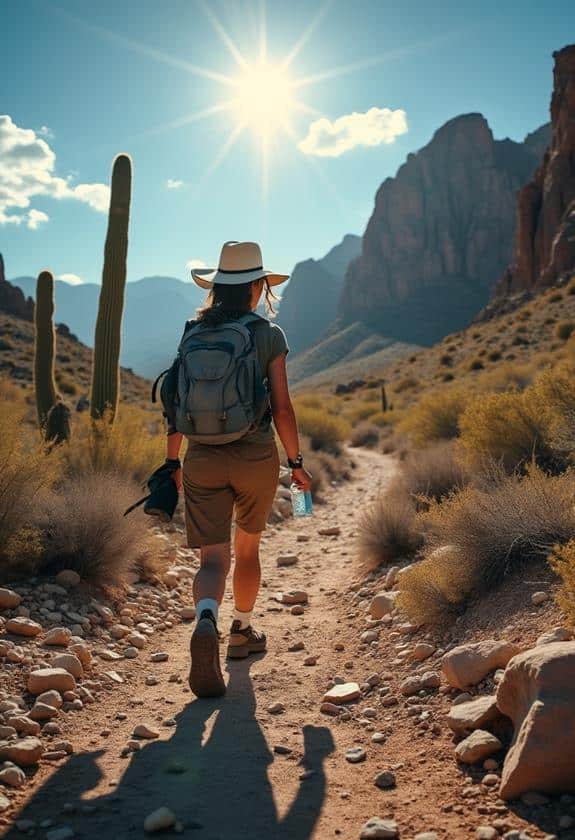
When hiking in extreme heat, choose a trail that matches your fitness level and check the weather forecast for safety. Plan your route with a detailed map, noting landmarks and water sources. Wear light-colored, breathable clothes, a wide-brimmed hat, and sunscreen for sun protection. Carry at least half a liter of water per hour of hiking and take breaks every 30 to 60 minutes in shaded areas. Monitor your physical condition for signs of heat illness like dizziness or heavy sweating. It's important to pack a basic emergency kit with essentials like a first aid kit and water purification tablets. Explore more to stay safe during your adventure.
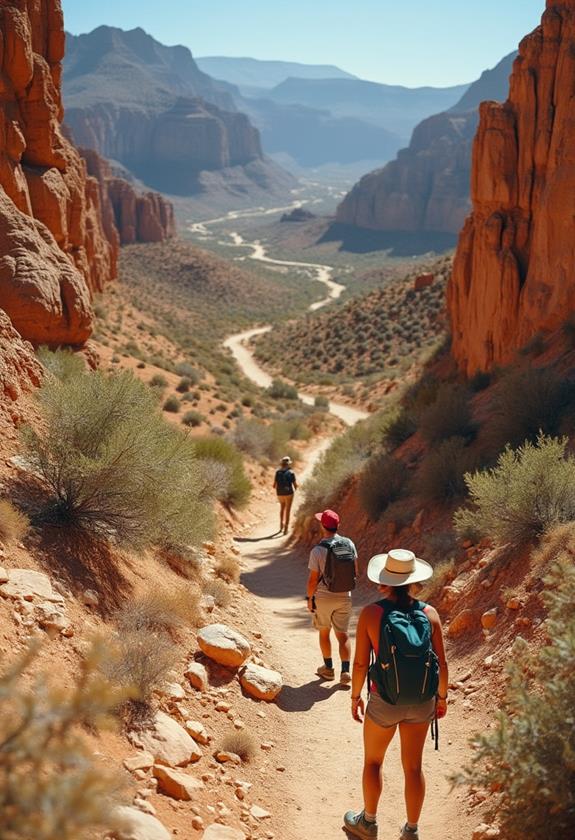
Selecting the right trail is essential for a safe and enjoyable hike. First, consider your fitness level. Choose a trail that matches your experience to avoid unnecessary risks. New hikers should look for shorter, well-marked paths with gentle slopes. More experienced hikers can explore longer, more challenging routes. Second, research the trail's difficulty rating and terrain. Trails are often rated as easy, moderate, or difficult. Pay attention to factors like elevation gain and types of surfaces. Third, check weather conditions. Some trails become dangerous in extreme heat. Fourth, study trail maps to understand distances and landmarks. Finally, guarantee you have the necessary gear for the trail you've chosen, like water, snacks, and proper footwear. This careful selection guarantees a safer and more enjoyable adventure.

Before you set out on your hiking adventure, planning your route carefully is essential for your safety and enjoyment. Start by selecting a trail that matches your skill level. Look for a detailed map of the area, noting key landmarks and potential hazards. Identify water sources, rest areas, and exit points along the way. Make sure the route allows enough time for breaks and rest. Estimate how long the hike will take, factoring in the terrain and your pace. Share your plan with a friend or family member, letting them know your expected return time. Familiarize yourself with the trail markers to avoid getting lost. Carry a physical map and compass as electronic devices might fail.
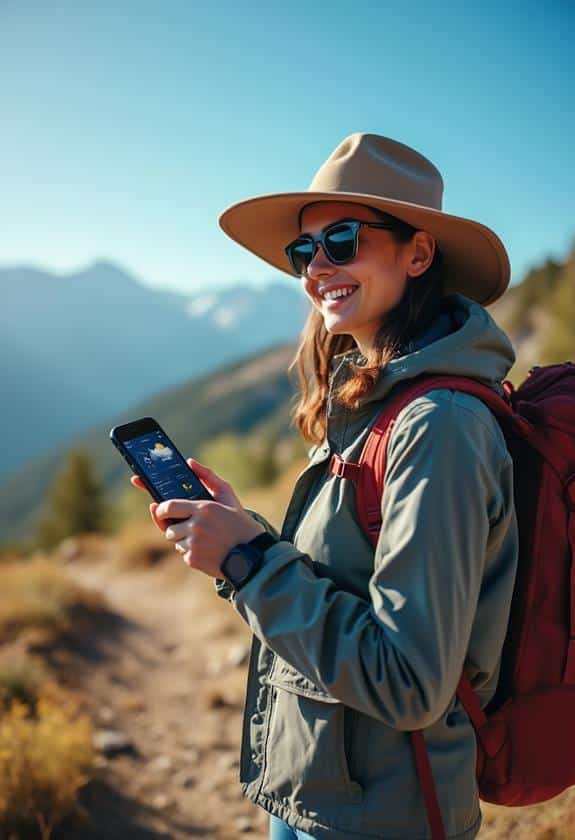
Don't underestimate the importance of checking the weather forecast before heading out on your hike. Knowing the weather conditions helps you prepare better and make safe decisions. Start by looking at the detailed forecast for the specific area you'll be hiking in. Pay attention to temperature highs and lows, wind speeds, and the chance of precipitation. Extreme heat can lead to dehydration and heat exhaustion, so it's crucial to know how hot it will get. Also, check for any weather alerts or warnings that might affect your plans. If conditions seem dangerous, consider postponing your hike. Regularly update yourself on changes in the forecast as the weather can be unpredictable. Being informed keeps you safe and ready for whatever nature brings.
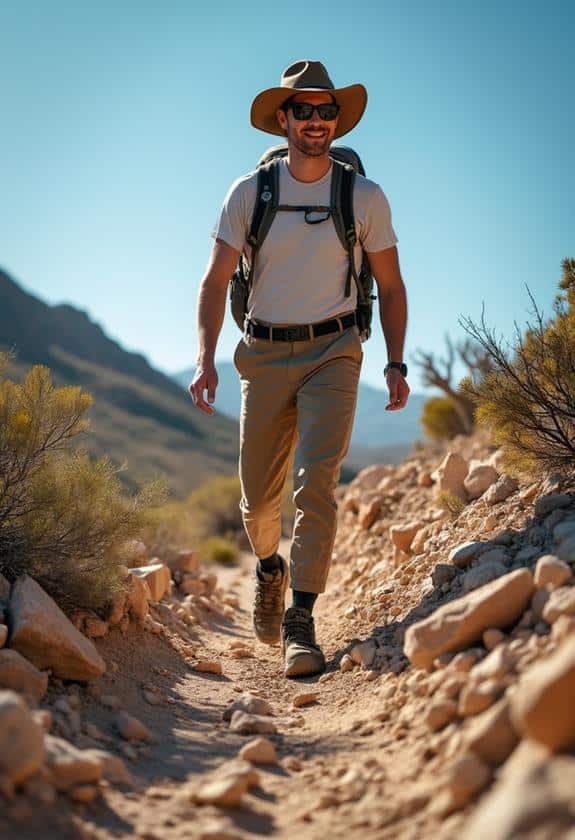
When you're heading out on a hike, wearing the right clothing can greatly impact your comfort and safety. In extreme heat, choose light-colored, loose-fitting clothes that help keep you cool. These clothes reflect sunlight, unlike dark colors that absorb heat, making you feel even warmer. Opt for breathable fabrics like cotton or moisture-wicking materials that help sweat evaporate, keeping you dry. It's wise to wear a wide-brimmed hat to protect your face and neck from the sun's rays. Sunglasses with UV protection shield your eyes, minimizing glare. Don't forget to apply sunscreen on exposed skin to prevent sunburn. Footwear is essential; wear sturdy hiking boots or shoes with good grip to avoid slips and guarantee stability on rocky paths.
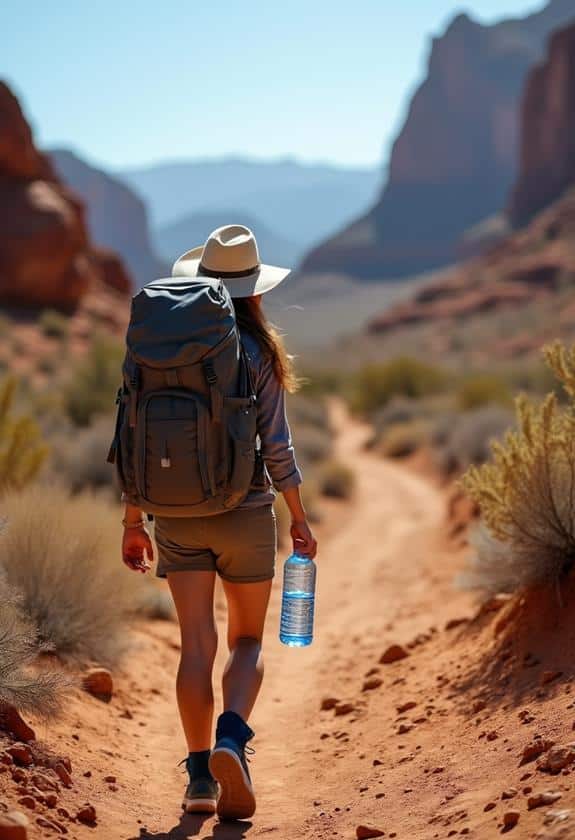
As you gear up with the right clothing, it's equally important to guarantee you pack enough water for your hike. Start by estimating how long you'll be hiking. A good rule of thumb is to carry at least half a liter of water per hour of hiking. If your hike lasts several hours, bring extra water. Consider using a hydration bladder, which allows you to sip water without stopping.
Although it might seem like a small detail, wearing sunscreen and a hat is essential for protecting yourself from the sun's harmful rays while hiking. The sun can be harsh, especially during long hikes, so take steps to protect your skin. Apply sunscreen at least 15 minutes before starting your hike, and make sure it's water-resistant and has a high SPF. Reapply every two hours, or more often if you're sweating heavily. A wide-brimmed hat will shield your face and neck from direct sunlight, keeping you cooler and safeguarding your skin. Remember to:
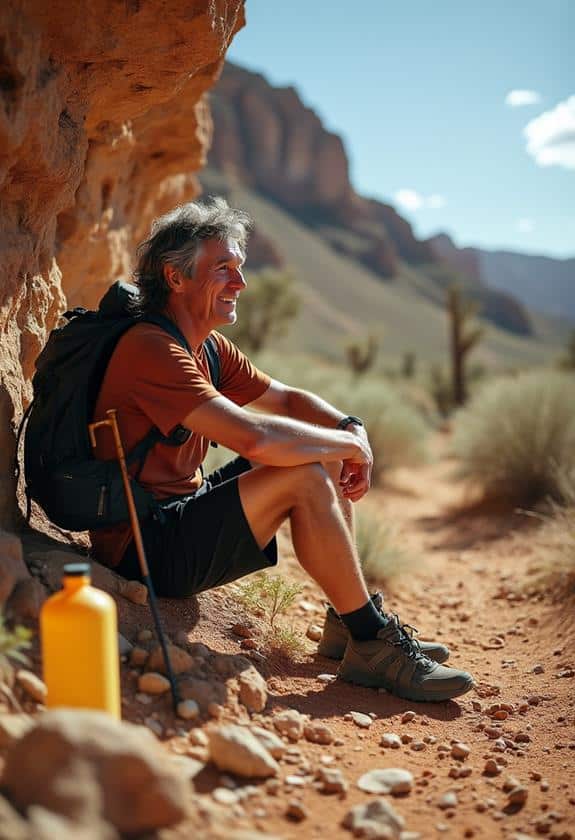
How often do you pause to appreciate the beauty around you while hiking? Scheduling rest breaks not only lets you enjoy the scenery but also helps you manage your energy in extreme heat. Plan to stop every 30 to 60 minutes. Find a shaded spot if possible, sit down, and drink water to stay hydrated. Resting allows your body to cool down, reducing the risk of heat-related illnesses.
Use these breaks to assess your route and adjust your pace if needed. While resting, stretch your muscles to prevent cramps and stiffness. Set a timer if you tend to lose track of time—keeping breaks consistent is key. Remember, planning and sticking to scheduled rest breaks can make your hike safer and more enjoyable.
Keep an eye on how your body feels during a hike to guarantee you don't push yourself too hard. It's essential to stay aware of your physical condition, especially in extreme heat. Pay attention to any signs of fatigue or discomfort, and take action to prevent overexertion. You can do this by:
These steps can help you maintain a safe and enjoyable hiking experience.

As you monitor your physical condition, it's important to recognize the signs of heat illness to guarantee your safety. First, pay attention to heavy sweating, as it may indicate your body's struggling to stay cool. Next, watch for signs of heat exhaustion, such as dizziness, nausea, or muscle cramps. If you experience headaches or feel weak, these might also be warning signs. Heatstroke, a severe condition, could occur if your skin feels hot and dry, or if you stop sweating altogether. Confusion or fainting are serious indicators that require immediate attention. Regularly check your pulse, since a rapid heart rate can signal heat stress. By knowing these symptoms, you can protect yourself and take immediate action if needed.
Preparing for emergencies is essential when hiking, ensuring you're ready for unexpected situations. You should always plan for potential problems, especially in extreme heat. Start by packing a basic emergency kit. This kit should include items that can help you handle emergencies and stay safe until help arrives. Here's what you need:
Imagine the sun as a relentless giant, its rays pouring down like molten gold. To acclimate, start by hiking shorter trails early in the morning, when it's cooler. Gradually increase your time in the heat, allowing your body to adjust. Hydrate constantly, carrying enough water to stay quenched. Wear light, breathable clothing and a hat to shield your skin. Listen to your body, resting often, and avoiding the hottest part of the day.
While hiking, watch for signs of dehydration, like dizziness, headache, or dark urine. You might feel very thirsty, have a dry mouth, or notice you're sweating less than usual. Pay attention to muscle cramps and feeling unusually tired. It's important to drink water regularly, even if you don't feel thirsty. If you notice any of these symptoms, take a break in the shade, rest, and drink water immediately.
Before hiking in hot weather, think of your body as a car needing fuel. Start with foods rich in carbs like whole-grain bread or oatmeal, providing long-lasting energy. Add proteins like eggs or nuts, which help repair muscles. Include fruits like bananas or oranges for natural sugars and hydration. Don't forget to drink plenty of water before you start. This balanced intake prepares your body, helping you endure the heat efficiently.
To prevent blisters in high temperatures, wear well-fitting, moisture-wicking socks and breathable shoes. First, make sure your shoes aren't too tight or loose. Before hiking, apply blister prevention products like moleskin or blister pads to common trouble spots. Keep your feet dry by changing socks if they get sweaty. Also, try using foot powder to reduce moisture. Finally, take breaks to check your feet and adjust your gear as needed.
Did you know that about 80% of wildlife encounters happen during heatwaves? If you encounter wildlife, stay calm and keep your distance. Slowly back away, avoiding sudden movements. Don't attempt to feed or touch the animal. Make yourself look larger by raising your arms. If the animal approaches, speak firmly and retreat to a safe distance. Always carry a whistle or noise-making device to alert the animal and discourage its advances.
